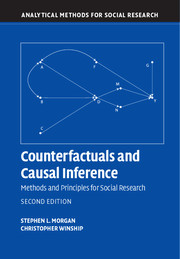Book contents
- Frontmatter
- Dedication
- Contents
- List of Figures
- List of Tables
- Acknowledgments for First Edition
- Acknowledgments for Second Edition
- I Causality and Empirical Research in the Social Sciences
- II Counterfactuals, Potential Outcomes, and Causal Graphs
- III Estimating Causal Effects by Conditioning on Observed Variables to Block Back-Door Paths
- IV Estimating Causal Effects When Back-Door Conditioning Is Ineffective
- V Estimation When Causal Effects Are Not Point-Identified by Observables
- 12 Distributional Assumptions, Set Identification, and Sensitivity Analysis
- VI Conclusions
- References
- Index
12 - Distributional Assumptions, Set Identification, and Sensitivity Analysis
Published online by Cambridge University Press: 05 December 2014
- Frontmatter
- Dedication
- Contents
- List of Figures
- List of Tables
- Acknowledgments for First Edition
- Acknowledgments for Second Edition
- I Causality and Empirical Research in the Social Sciences
- II Counterfactuals, Potential Outcomes, and Causal Graphs
- III Estimating Causal Effects by Conditioning on Observed Variables to Block Back-Door Paths
- IV Estimating Causal Effects When Back-Door Conditioning Is Ineffective
- V Estimation When Causal Effects Are Not Point-Identified by Observables
- 12 Distributional Assumptions, Set Identification, and Sensitivity Analysis
- VI Conclusions
- References
- Index
Summary
In this chapter, we consider how analysts can proceed when no observed variables are available to point-identify and then estimate causal effects using the procedures explained in prior chapters. We discuss three complementary approaches. First, we will review the early literature on selection-bias adjustment, which shows clearly how distributional assumptions about unobservables, when harnessed from within a structural model, can identify causal parameters of interest. Point identification and estimation utilizing this strategy was frequent before it became clear to researchers in the 1990s how rarely the required distributional assumptions were warranted for their applications. The more recent selection-bias adjustment literature offers less restrictive semiparametric methods, but it also reemphasizes the relative value of instrumental variables in contrast to distributional assumptions for unobservables.
We will then consider the exact opposite strategy. Rather than place strong and usually untestable assumptions on the distributional characteristics of unobservables, the set-identification approach asks what can be learned about particular causal parameters by asserting only weak but defendable assumptions about unobserved variables. Instead of attempting to point-identify average causal effects, the set-identification approach suggests that it is more credible to try to limit the interval within which an average treatment effect must fall.
Finally, we will consider the related approach known as sensitivity analysis. Here, the analyst offers an estimate based on the provisional maintenance of an identifying assumption – most often, ignorability or selection on the observables – and then assesses the extent to which the estimate would vary as violations of the identifying assumption increase in severity.
- Type
- Chapter
- Information
- Counterfactuals and Causal InferenceMethods and Principles for Social Research, pp. 419 - 434Publisher: Cambridge University PressPrint publication year: 2014



